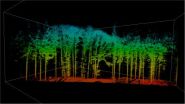(Press-News.org) Trees have been growing significantly faster since the 1960s. The typical development phases of trees and stands have barely changed, but they have accelerated -- by as much as 70 percent. This was the outcome of a study carried out by scientists from Technische Universität München based on long-term data from experimental forest plots that have been continuously observed since 1870. Their findings were published recently in Nature Communications.
Three decades ago, "forest dieback" was a hot topic, with the very survival of large forest ecosystems seemingly in doubt. But instead of a collapse, the latest studies indicate that forests have actually been growing at a faster rate. Whether, how and why forest stands have changed their growth patterns over the last century are still hotly disputed questions.
This latest study provides some answers. It was based on data from experimental forest plots that have been observed systematically since 1870. This makes them among the oldest forest study sites in the world. The forested areas are also representative of the typical climate and environmental conditions found in Central Europe. "Our findings are based on a unique data pool," maintains Prof. Hans Pretzsch from TUM's Chair for Forest Growth and Yield, who headed up the study.
Accelerated Growth
In the cases of spruce and beech, respectively the dominant species of coniferous and deciduous trees in Central Europe, the TUM scientists noted significantly accelerated tree growth. Beech trees exhibited a growth rate that was 77 percent faster than in 1960, while the figure for spruce was 32 percent faster. The stand volume growth for beech was 30 percent, and 10 percent for spruce. "The stands as a whole had a lower growth rate than the individual trees essentially because larger trees require more space, hence each stand will have fewer trees," explains Pretzsch.
The scientists are putting the growth acceleration down to rising temperatures and the extended growing season. Carbon dioxide (CO2) and nitrogen are other factors contributing to the faster growth. The concentrations of these gases in the atmosphere have been rising steadily over the last century. "Interestingly, we observed that acid rain only had a temporary slowing effect on the growth of our experimental plots. Indeed, the input of pollutants started to fall off significantly from the 1970s," says Pretzsch. "It is true though that only a few of our experimental areas are located in the ridges of the highland mountains where the greatest damage was observed."
Change Requires Adaptation
While the trees both grow and age faster, the appearance of the forest does not change as a result. But the same tree and stand sizes are achieved significantly earlier than in the past. This could benefit the forestry industry in that target diameters and the optimal harvest rotation age will be reached sooner. Besides, more wood can be harvested without compromising the principle of sustainability.
At the same time, the altered timescale has not yet been incorporated into traditional forestry yield models, which monitor growth merely as a function of age. The risk here is that the newly discovered benefits will not be exploited. Meanwhile, the accelerated growth and ageing of trees is also significant for the forest ecosystem as a whole, as Pretzsch explains: "The plant and animal species that will be most affected are those living in habitats which depend on special phases and structures of forest development. These species may have to become more mobile to survive."
Long-term Observation Provides Unique Pool of Data
The study was based on 600,000 individual tree surveys conducted since 1870. Over such a long timescale, it was possible to determine from the growth of the trees how they responded to changing environmental conditions. Pretzsch adds: "Even though the experimental areas varied in terms of climate and soil conditions, we were still able to discern an overall trend of faster growth."
But it is not just the experimental plots and the long observation period that make the data so interesting. "We did not observe the trees in isolation, but rather always in interaction with their neighbors. This helped us understand how the dynamics of individual trees influence the stand as a whole. The growth trends at stand level are relevant for the forestry industry in terms of productivity, carbon sequestration and climate risks," concludes Pretzsch.
INFORMATION:
Publication
Forest stand growth dynamics in Central Europe have accelerated since 1870,
Pretzsch, H., Biber, P., Schütze, G., Uhl, E., Rötzer, Th., (2014)
Nat. Commun. 5:4967 doi:10.1038/ncomms5967
More Information
The network of experimental plots: http://www.wwk.forst.tu-muenchen.de/acquisition/versuchswesen/vfl/
Measurement techniques for trees and stands: http://www.wwk.forst.tu-muenchen.de/acquisition/messtechnik/
Contact
Prof. Dr. Dr. h. c. Hans Pretzsch
Technische Universität München
Chair for Forest Growth and Yield
+49 8161 71-4711
hans.pretzsch@tum.de
http://www.wwk.forst.tu-muenchen.de/
Global change: Trees continue to grow at a faster rate
Study highlights forest growth trends from 1870 to the present
2014-09-17
ELSE PRESS RELEASES FROM THIS DATE:
Nanoscience makes your wine better
2014-09-17
One sip of a perfectly poured glass of wine leads to an explosion of flavours in your mouth. Researchers at Aarhus University, Denmark, have now developed a nanosensor that can mimic what happens in your mouth when you drink wine. The sensor measures how you experience the sensation of dryness in the wine.
When wine growers turn their grapes into wine, they need to control a number of processes to bring out the desired flavour in the product that ends up in the wine bottle. An important part of the taste is known in wine terminology as astringency, and it is characteristic ...
The mobility model is closely linked to the city's characteristics
2014-09-17
This news release is available in Spanish and Spanish.
As far as the conclusions of the study are concerned, the following aspects, among others, are worth highlighting: the more compact the town or city is, the more concentrated is its population; the more jobs there are in the municipality itself, etc., the less private vehicles are used; the better the offer of public transport, the lower the number of people who use private cars; the higher the per capita income is (in small localities), the greater is the tendency to use the private car. According to Mendiola, ...
Magnetic resonance helps to detect and quantify fat in liver
2014-09-17
This news release is available in Spanish.
Obesity and overweight affect more than half of the population in our Community. Excess weight causes important alterations in the organism, one of which affects liver function. Fat accumulates in the liver producing hepatic steatosis which, in certain circumstances, causes inflammation, fibrosis and finally, cirrhosis. To date, the most reliable method for determining hepatic fat has been hepatic biopsy. Imaging techniques such as abdominal ecography detect it but are less precise for determining the quantity of fat.
But ...
Car hacking: The security threat facing our vehicles
2014-09-17
The car of the future will be safer, smarter and offer greater high-tech gadgets, but be warned without improved security the risk of car hacking is real, according to a QUT road safety expert.
Professor Andry Rakotonirainy will speak at the Occupational Safety in Transport Conference (OSIT) on the Gold Coast on September 18-19 on the security threat facing drivers as vehicles become computers on wheels.
Professor Rakotonirainy, from QUT's Centre for Accident Research & Road Safety - Queensland (CARRS), has researched the security systems of existing fleet, future ...
Survey finds benefits, risks of yoga for bipolar disorder
2014-09-17
PROVIDENCE, R.I. [Brown University] — Right now no one can say whether yoga provides clinical benefits to people with bipolar disorder, but in a new article in the Journal of Psychiatric Practice, researchers report survey responses they gathered from scores of people with the condition who practice yoga. What the collective testimony suggests is that yoga can be a substantial help, but it sometimes carries risks, too.
"There is no scientific literature on hatha yoga for bipolar disorder," said lead author Lisa Uebelacker, associate professor (research) of psychiatry ...
Cape Cod saltmarsh recovery looks good, falls short
2014-09-17
PROVIDENCE, R.I. [Brown University] — After decades of decline, grasses have returned to some once-denuded patches of Cape Cod's saltmarshes. To the eye, the marsh in those places seems healthy again, but a new study makes clear that a key service of the marsh – coastal protection – remains diminished.
"We've got the aesthetics back but the ecosystem function hasn't come back," said ecologist Mark Bertness, professor of biology at Brown and senior author of the study in the journal Biological Conservation. "The metric of a recovered habitat should not be 'Does it look ...
Recruiting bacteria to be technology innovation partners
2014-09-17
For most people biofilms conjure up images of slippery stones in a streambed and dirty drains. While there are plenty of "bad" biofilms around – they even cause pesky dental plaque and a host of other more serious medical problems – a team at the Wyss Institute for Biologically Inspired Engineering at Harvard University sees biofilms as a robust new platform for designer nanomaterials that could clean up polluted rivers, manufacture pharmaceutical products, fabricate new textiles, and more.
In short, they want to give biofilms a facelift, and have developed a novel protein ...
Phthalates heighten risk for childhood asthma
2014-09-17
Researchers at the Columbia Center for Children's Environmental Health at the Mailman School of Public Health are the first to demonstrate an association between childhood asthma and prenatal exposure to two phthalates used in a diverse array of household products. Results appear online in the journal Environmental Health Perspectives.
Children born to mothers exposed during pregnancy to higher levels of the chemicals, butylbenzyl phthalate (BBzP) and di-n-butyl phthalate (DnBP) had a 72 percent and 78 percent increase in risk of developing asthma between age 5 and 11, ...
New study examines the impact of socioeconomic position & maternal morbidity in Australia
2014-09-17
The risk of severe maternal morbidity amongst women in Australia is increased by lower socioeconomic position, suggests a new study published today (17 September) in BJOG: An International Journal of Obstetrics and Gynaecology.
Australians generally enjoy high standards of living; however, existing research has concluded that health disparities exist, in particular between indigenous and non indigenous Australians.
This case-control study aimed to explore the independent impact of socioeconomic position on severe maternal morbidities associated with direct maternal ...
A greater focus on socially disadvantaged women is needed to improve maternity care in England
2014-09-17
Women from lower socioeconomic groups in the UK report a poorer experience of care during pregnancy and there needs to be a greater focus on their care, suggests a new study published today (17 September) in BJOG: An International Journal of Obstetrics and Gynaecology (BJOG).
Differences in health outcomes amongst different socioeconomic groups have been demonstrated in many areas and have provided the focus for national initiatives in the UK to reduce the observed inequalities.
The Oxford University study, funded by the National Institute for Health Research, explores ...
LAST 30 PRESS RELEASES:
COVID-19 leaves a lasting mark on the human brain
Scientists use ultrasound to soften and treat cancer tumors without damaging healthy tissue
Community swimming program for Black youth boosts skills, sense of belonging, study finds
Specific depressive symptoms in midlife linked to increased dementia risk
An ‘illuminating’ design sheds light on cholesterol
Who is more likely to get long COVID?
Study showcases resilience and rapid growth of “living rocks”
Naval Research Lab diver earns Office of Naval Research 2025 Sailor of the Year
New Mayo-led study establishes practical definition for rapidly progressive dementia
Fossil fuel industry’s “climate false solutions” reinforce its power and aggravate environmental injustice
Researchers reveal bias in a widely used measure of algorithm performance
Alcohol causes cancer. A study from IOCB Prague confirms damage to DNA and shows how cells defend against it
Hidden viruses in wastewater treatment may shape public health risks, study finds
Unlock the power of nature: how biomass can transform climate mitigation
Biochar reshapes hidden soil microbes that capture carbon dioxide in farmland
Reducing saturated fat intake shows mortality benefit, but only in high-risk individuals
Manta rays create mobile ecosystems, study finds
Study: Mixed results in using lipoic acid to treat progressive multiple sclerosis
Norbert Holtkamp appointed director of Fermi National Accelerator Laboratory
New agentic AI platform accelerates advanced optics design
Biologists discover neurons use physical signals — not electricity — to stabilize communication
Researchers discover that a hormone can access the brain by hitchhiking
University of Oklahoma researcher awarded funding to pursue AI-powered material design
Exploring how the visual system recovers following injury
Support for parents with infants at pediatric check-ups leads to better reading and math skills in elementary school
Kids’ behavioral health is a growing share of family health costs
Day & night: Cancer disrupts the brain’s natural rhythm
COVID-19 vaccination significantly reduces risk to pregnant women and baby
The role of vaccination in maternal and perinatal outcomes associated with COVID-19 in pregnancy
Mayo Clinic smartwatch system helps parents shorten and defuse children's severe tantrums early
[Press-News.org] Global change: Trees continue to grow at a faster rateStudy highlights forest growth trends from 1870 to the present






